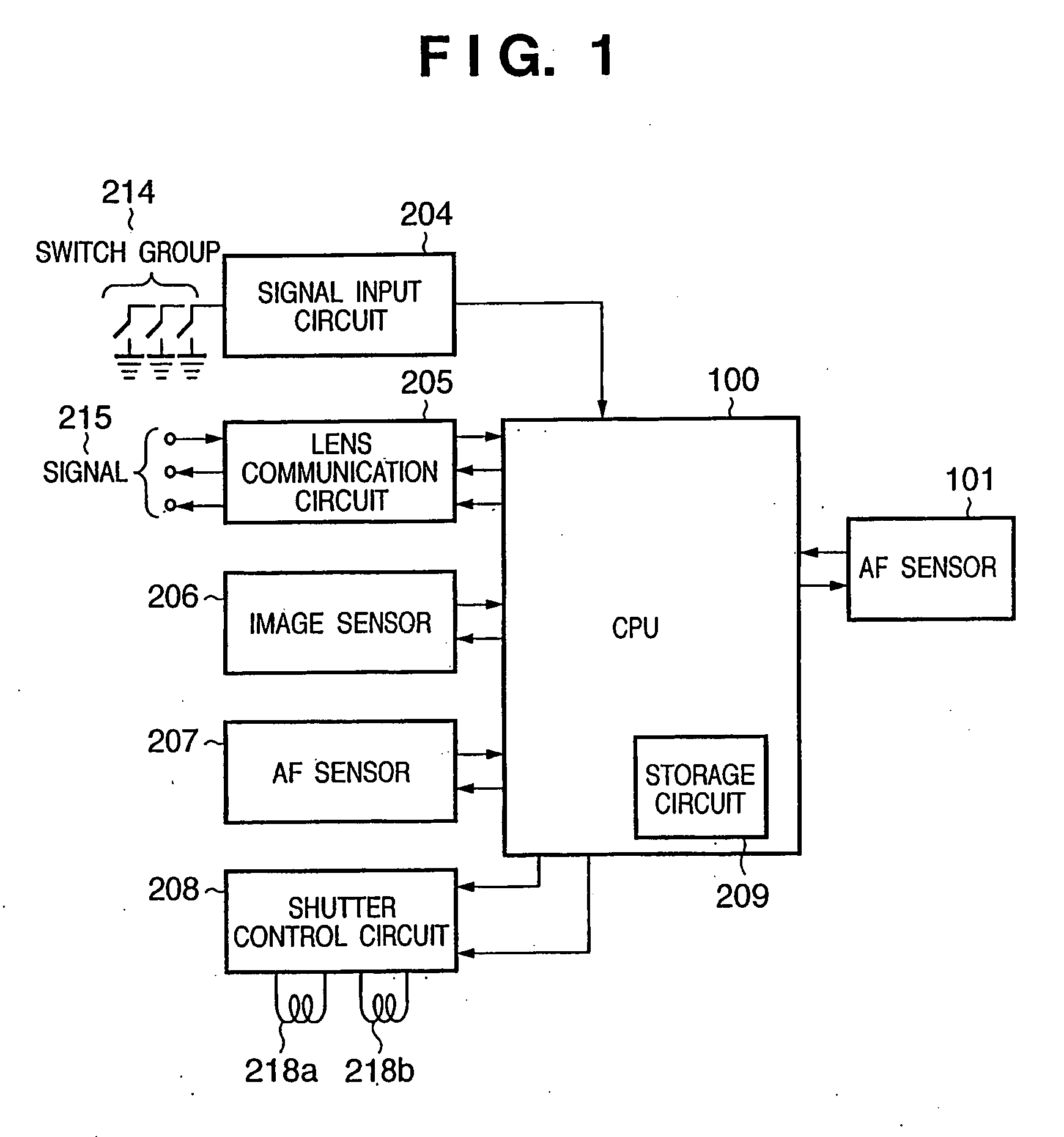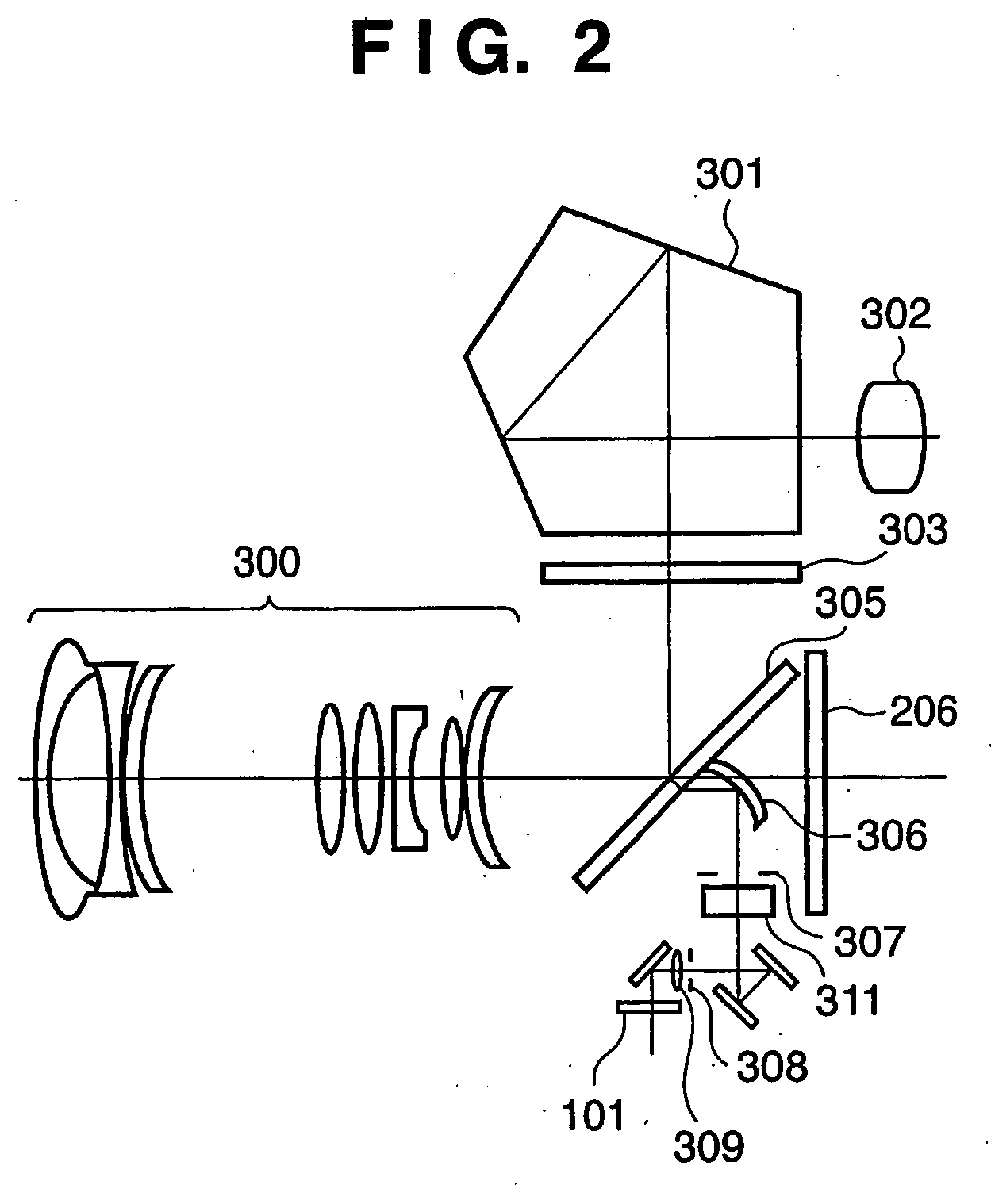Focus State Detection Apparatus and Optical Instrument
- Summary
- Abstract
- Description
- Claims
- Application Information
AI Technical Summary
Benefits of technology
Problems solved by technology
Method used
Image
Examples
first embodiment
[0050]FIG. 1 is a block diagram showing the circuit arrangement of a camera according to the first embodiment of the present invention. Referring to FIG. 1, a signal input circuit 204 for detecting a switch group 214 for various kinds of operations of the camera, an image sensor 206, an AF sensor 207, a shutter control circuit 208 for controlling shutter magnets 218a and 218b, and an AF sensor 101 are connected to a camera microcomputer (to be referred to as a CPU hereinafter) 100. The CPU 100 transmits a signal 215 to a photographing lens (to be described later) through a lens communication circuit 205 to perform control for a focus position and a stop. The operation of the camera is determined by the setting of the switch group 214.
[0051]The AF sensor 101 comprises a pair of line sensors. The CPU 100 controls the AF sensor 101 to detect a defocus amount from the contrast distribution of an object to be photographed which is obtained by the line sensors, thereby controlling the foc...
second embodiment
[0087]In the focus detection apparatus according to the first embodiment described above, when the area C is enlarged, the areas L and R become narrow. As a result, the detection range of defocus amounts becomes narrow. A technique for solving this problem will be described below as the second embodiment of the present invention.
[0088]FIG. 13 is a block diagram showing the arrangement of a camera according to the second embodiment of the present invention. The same reference numerals as in FIG. 1 denote the same parts in FIG. 13.
[0089]An AF sensor 401 comprises two pairs of line sensors. A CPU 100 incorporates a timer 400 for measuring the accumulation time in the AF sensor 401. Other arrangements are the same as those shown in FIG. 1, and hence a description thereof will be omitted.
[0090]The relationship between the line sensors on the AF sensor 401 and distance measurement points in a photographing frame will be described with reference to FIGS. 14 and 15.
[0091]FIG. 14 is a view s...
third embodiment
[0112]The third embodiment of the present invention will be described next. FIG. 19 is a view showing a distance measurement principle using a focus detection apparatus according to the third embodiment of the present invention.
[0113]In the third embodiment, a photographing lens 603 is placed in front of a distance measurement unit 610. The focus state can be changed by changing the position of the photographing lens 603 between an object 601 to be photographed and the distance measurement unit 610, and more specifically, moving the photographing lens 603 in the vertical direction in FIG. 19 (the direction indicated by the arrow in FIG. 19). In the case shown in FIG. 19, a one-bar chart plate (a chart plate with one bar) is used as the object 601.
[0114]The distance measurement unit 610 is provided with a field lens 611, a stop 612, a secondary imaging spectacle lens 613 having two lenses combined, and a light-receiving sensor 614. Unnecessary light beams of light beams passing throu...
PUM
 Login to View More
Login to View More Abstract
Description
Claims
Application Information
 Login to View More
Login to View More - R&D
- Intellectual Property
- Life Sciences
- Materials
- Tech Scout
- Unparalleled Data Quality
- Higher Quality Content
- 60% Fewer Hallucinations
Browse by: Latest US Patents, China's latest patents, Technical Efficacy Thesaurus, Application Domain, Technology Topic, Popular Technical Reports.
© 2025 PatSnap. All rights reserved.Legal|Privacy policy|Modern Slavery Act Transparency Statement|Sitemap|About US| Contact US: help@patsnap.com



